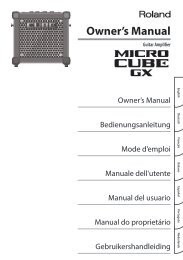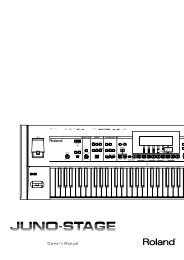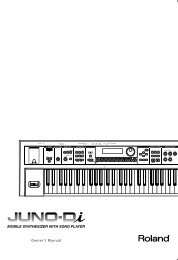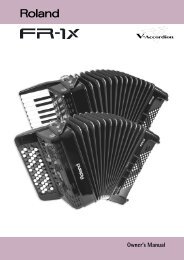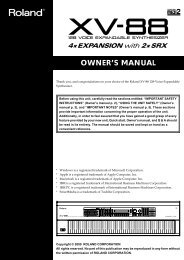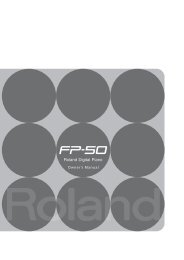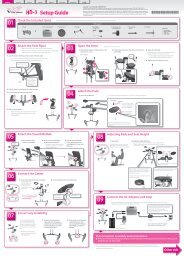Owner's Manual - Roland
Owner's Manual - Roland
Owner's Manual - Roland
Create successful ePaper yourself
Turn your PDF publications into a flip-book with our unique Google optimized e-Paper software.
Creating a Patch<br />
Delay Time (LFO1/LFO2 Delay Time)<br />
118<br />
Delay Time (LFO Delay Time) specifies the time elapsed<br />
before the LFO effect is applied (the effect continues) after<br />
the key is pressed (or released).<br />
Value: 0–127<br />
After referring to How to Apply the LFO (p. 119),<br />
change the setting until the desired effect is achieved.<br />
When using violin, wind, or certain other instrument<br />
sounds in a performance, rather than having vibrato<br />
added immediately after the sounds are played, it can<br />
be effective to add the vibrato after the note is drawn<br />
out somewhat. If you set the Delay Time in conjunction<br />
with the Pitch Depth parameter and Rate parameter, the<br />
vibrato will be applied automatically following a certain<br />
interval after the key is pressed. This effect is called<br />
Delay Vibrato.<br />
Delay Time KF<br />
(LFO1/LFO2 Delay Time Keyfollow)<br />
fig.06-031.e<br />
Adjusts the value for the Delay Time parameter depending<br />
on the key position, relative to the C4 key (center C). To<br />
decrease the time that elapses before the LFO effect is<br />
applied (the effect is continuous) with each higher key that is<br />
pressed in the upper registers, select a positive value; to<br />
increase the elapsed time, select a negative value. Larger<br />
settings will produce greater change. If you do not want the<br />
elapsed time before the LFO effect is applied (the effect is<br />
continuous) to change according to the key pressed, set this<br />
to “0.”<br />
Value: -100, -90, -80, -70, -60, -50, -40, -30, -20, -10, 0,<br />
+10, +20, +30, +40, +50, +60, +70, +80, +90, +100<br />
Time<br />
C1 C2 C3 C4 C5 C6 C7<br />
-100<br />
0<br />
-50<br />
+50<br />
+100<br />
Key<br />
Fade Mode (LFO1/LFO2 Fade Mode)<br />
Specifies how the LFO will be applied.<br />
Value: ON-IN, ON-OUT, OFF-IN, OFF-OUT<br />
After referring to How to Apply the LFO (p. 119),<br />
change the setting until the desired effect is achieved.<br />
Fade Time (LFO1/LFO2 Fade Time)<br />
Specifies the time over which the LFO amplitude will reach<br />
the maximum (minimum).<br />
Value: 0–127<br />
After referring to How to Apply the LFO (p. 119),<br />
change the setting until the desired effect is achieved.<br />
Key Trigger (LFO1/LFO2 Key Trigger)<br />
This specifies whether the LFO cycle will be synchronized to<br />
begin when the key is pressed (ON) or not (OFF).<br />
Value: OFF, ON<br />
Pitch Depth (LFO1/LFO2 Pitch Depth) ★<br />
Specifies how deeply the LFO will affect pitch.<br />
Value: -63– +63<br />
TVF Depth (LFO1/LFO2 TVF Depth) ★<br />
Specifies how deeply the LFO will affect the cutoff frequency.<br />
Value: -63– +63<br />
TVA Depth (LFO1/LFO2 TVA Depth) ★<br />
Specifies how deeply the LFO will affect the volume.<br />
Value: -63– +63



